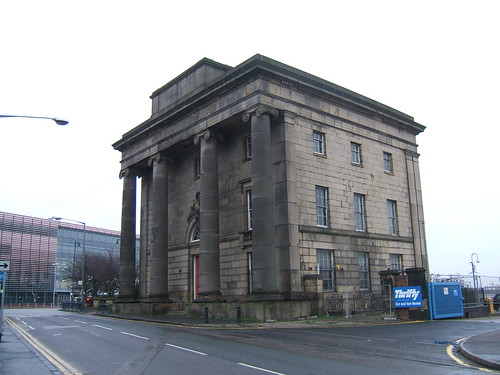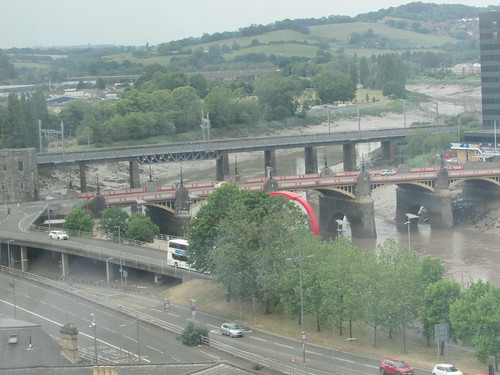Sunday travel is rarely convenient on the British Railway Network as it's a favourite day for Network Rail to carry out engineering works, frequently substituting Rail Replacement Bus Services for part or all of the route of scheduled trains. I expected to find a Cross Country service via Bristol Parkway but, instead there appeared to be a number of trains running between Nottingham and Newport via Gloucester, with a bus service forward to Cardiff. I pre-booked tickets online.
On Sunday, Dean took me by road to Wolverhampton station in plenty of time to catch my first train to Birmingham New Street. At Birmingham, I made my way to the wide concourse area connecting the different platforms. The station was very busy but I easily located the Passenger Information Screens which showed my train approaching platform 12 on time. After purchasing food for the onward journey, I made my way to the platform which was crammed with passengers. Platform 12 is the highest-numbered platform, sharply-curved on the southern side of the station.
The first station in Birmingham was the 1838 Curzon Street, equipped with a suitably grand building by the London and Birmingham Railway. Although the grade 1 listed building survives, it has been neglected for years. It's to become subsumed into the ridiculous new terminus being built for the unwanted and expensive HS2 railway.

Curzon Street station building in 2007
Curzon Street was relegated to a goods depot when New Street Station was built, one kilometre to the south-west. The rail approaches to New Street were all by tunnel so the cramped station was built in a 'hole in the ground' between the North and South tunnels. The London and North Western Railway managed to get straight platforms but the Midland Railway had to settle for curved platforms which are little changed today. Glazed, arched train shed roofing originally covered the platforms. That on the London and North Western side was lost, I think to bombing in the second world war, so I only remember the utilitarian umbrella roofing which replaced it but I remember the Midland side train shed which survived the war in a dingy and delapidated state. British Railways rebuilt the station by burying the whole area beneath a multi-storey building and its approaches. Even after electrification (and still today) many of the services remained diesel powered, ensuring an unpleasant environment for waiting passengers. Birmingham New Street held my 'Britain's most unpleasant station' award for many years until it was decided to rebuild the station again, creating years of additional confusion for passengers as the work proceeded. Unfortunately, because of the site constraints, few of the fundamental defects could be remedied, although I think platform ventilation is improved. The station now boasts an even larger shopping centre, styling itself 'Grand Central'. Having visited the rather better-known Grand Central in New York, I think the appropriation of the name at New Street is unjustified.

Grand Central, Birmingham New Street: Atrium showing retail outlets at Concourse Level and around the Gallery.
My train, a Class 170 3-car diesel multiple unit, arrived on time and a stream of passengers got off, to be replaced by the hordes waiting on the platform. I gratefully found my reserved seat and tucked myself in the corner. If I'd noticed just how many young people had boarded, I might not have been surprised when, at our first stop at University after just five minutes travel, a large number of passengers abandoned the train. Even after the exodus, the train remained pretty crowded. The next stop was Worcestershire Parkway. This is a recent addition, opened 2020, with a large car park. In addition to the two platforms on the former Midland route to Bristol (now called the 'Cross Country Line'), the station has a third platform on the Oxford and Worcester line which crosses over at this point. The Oxford and Worcester is marketed as the 'Cotswold Line' and is single line between Norton Junction (a little to the west of the new station) for the ten miles to Evesham.
Our next stop was Cheltenham Spa. Because of the Byzantine complexity of the pricing structure for train tickets, 'Split Ticketing' is now commonplace. For instance, it is often cheaper to buy a Birmingham-Cheltenham Spa ticket and a separate Cheltenham Spa-Newport ticket, rather than a combined Birmingham-Newport ticket. Many of the online booking services now incorporate this feature in their pricing automatically, requiring me to print and manage two tickets for the journey from Birmingham to Newport on one train. Leaving Cheltenham Spa, we bowled along happily until Barnwood Junction, where we diverged right onto the northern leg of the triangular junction leading to Gloucester. Once again, there was quite an interchange of passengers before we continued on our way, showing a decent turn of speed in between stops at Lydney, Chepstow and Caldicot.
Just after Caldicot, our route converged with the Great Western Main Line, rising up from the Welsh portal of the 4 mile 628 yard long Severn Junnel. It was clear from the 'Freightliner' Class 66 on a ballast train and the collection of yellow-liveried track machines that the tunnel route was under an Engineering Possession and not available to normal trains that day.

Ballast train and Track machines on the Great Western Main Line just east of Severn Tunnel Junction station viewed from Caldicot line
Continuing west from Severn Tunnel Junction, there are four running lines, paired by direction. The Bishton Flyover re-arranges the order of the lines into paired by use. This was presumably to facilitate freight traffic entering and leaving the massive Llanwern Steelworks site. Steelmaking ceased some years ago and much of the site is being re-developed by St. Modwen. Spain's CAF are assembling Class 197 'Civity' diesel multiple units for Transport for Wales at a thirty million pound new factory here. My train negotiated Maindee East Junction and Maindee West Junction where the Welsh Marches line to Hereford and Shrewsbury makes a triangular junction with the the South Wales Main Line, crossed over the River Usk and quietly came to a stand in platform 1 at Newport. On that day, the service was terminating at Newport, rather than continuing to Cardiff, so passengers for Cardiff were forced to complete their journey by a Rail Replacement bus.

Newport Station Platform 1, after arrival of Class 170 from Nottingham
I was booked into the Mercure Hotel for the night and had arranged that Steve M. would meet me later at the hotel for an evening meal. I toyed with the idea of a taxi for the short distance to the hotel but the weather was fine and I only had a small pull-along case so I decided to continue on foot. My route took me through what I imagine is now called the 'Hospitality Quarter' - pedestrianised streets of colourful bars and restaurants. Judging by the amount of litter I waded through on that Sunday afternoon, the previous night had been a commercial success. The hotel entrance was an unassuming affair in pedestrianised Upper Dock Street opposite Friars Walk Shopping Centre and Leisure Complex. Steps and a ramp led through glass doors to a spartan reception with a reception desk at the far end and lift doors on the left led to the rest of the hotel. Checking-in was quick and friendly and the lift took me to my room on the eighth floor. The room was well-appointed with a decent bed and an excellent en-suite shower, wash basin and W.C. The large window gave a splendid view across the River Usk and the east of the city. Upstream, to the left, the river was crossed by the arched road bridge called Newport Bridge, adjacent to the remains of Newport Castle, with the railway bridge beyond.

Newport, Wales: View from 8th floor, Mercure Hotel showing railway and road bridges over the Usk
Downstream, I could see the stark, modernist Newport City Footbridge, opened in 2006. This cable-stayed bridge is supported by two tubular steel 'A'-frames 80 metres and 69 metres in length giving the bridge a span of 145 metres. In the foreground, I had a detailed view of the flat roof of Friars Walk, covered with all sorts of heating and ventilating equipment and ducts. I took a leisurely shower and relaxed. My inclination is always to get out and explore an unfamiliar location but, tired from the travelling, I decided to settle for a 'virtual tour' by studying the book 'Newport History Tour' given to me by Steve. In the evening, I enjoyed a good meal in the hotel's restaurant with Steve and his partner before they returned home and I retired as I knew the following day would prove taxing. Steve arranged to return next morning in time for us to both have breakfast at the hotel before setting off for GCRE.
After a good night's sleep, I arose early and decided there was time for a brief exploration before Steve arrived for breakfast. My interest had been piqued by a reference in the 'Newport History Tour' book to Early Power Transformers in Park Square and I judged there was time to walk there and see for myself. It was a fine morning and the city centre was just starting to awake. I was delighted to see contractors scrubbing and washing pavements ready for the new day. I found a disused, preserved transformer near the top of Park Square. I'm used to cast iron cabinets installed on pavements mounting substantial fuses to protect street mains but the cylindrical, decorated pillar I found was a much grander affair. At some point, it had been nicely repainted in blue, with detailing picked out in pale blue and although there was obvious damage, it still looked quite handsome. I believe this relic dates from around 1894 when a power station in Llanarth Street, Newport distributed alternating current at 2,000 volts via rubber insulated cables to a series of these pillars where transformers extracted power at 200 volts a.c. for domestic use.

Newport, Wales: Park Square Transformer
There were tall, hinged doors at low level and smaller doors at high level. One of the larger doors had been opened and rusting on the hinges now prevented it from being closed, resulting in a collection of litter and leaves inside. The original transformer was still in situ, as shown below, but further study is needed to better understand the design.

Excited by what I'd found, I hurried back to the hotel for a sustaining English buffet breakfast with Steve before checking out. Steve and I then set off for the visit to GCRE.
Book references
[1] 'Newport History Tour' by Jan Preece (Amberley Publishing 2019) ISBN: 978 1 4456 9292 0.
Related posts on this website
Lionsmeet 2012 (A live-steam model event at Newport in 2012)
A Trip to South Wales (Part 2) (A visit to Newport in 2014)
Caldicot by Train (Travel on the same route in 2019)
Global Centre for Rail Excellence Open Day (Visit to GCRE)
My pictures
West Midland Railways.
Newport, Wales.
Newport area rail.
[Link to GCRE Visit post added: 9-Dec-2023]
